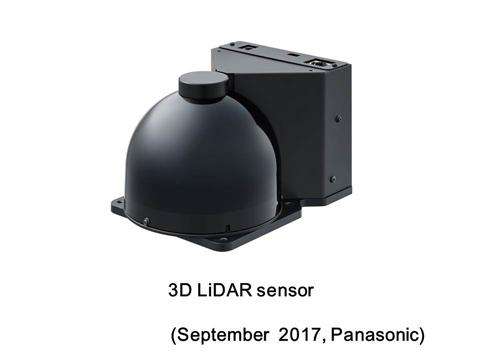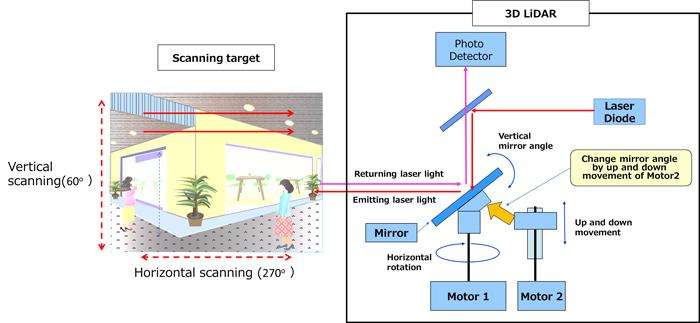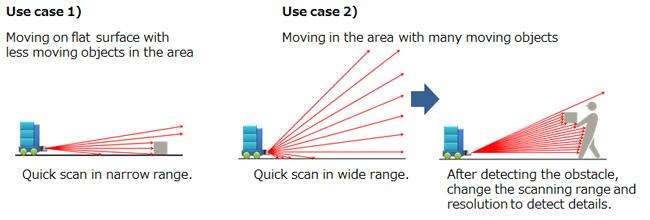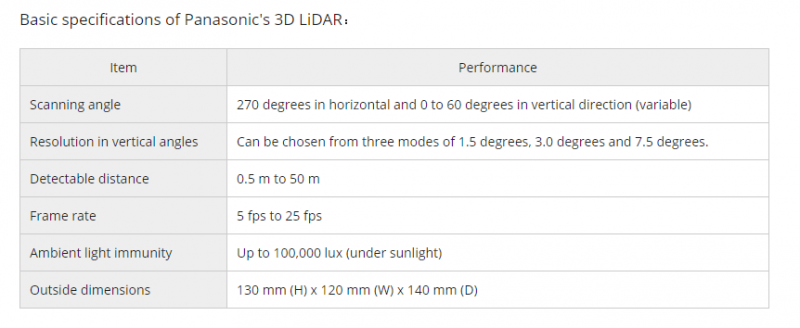3-D LiDAR sensor enabling detection of distances with wide angle of view

Panasonic Corporation announced today that it has developed a 3-D LiDAR sensor that accurately measure the direction of and distance to objects with a wide angle of view, which is critical for autonomous operation of mobile robots. Employing Panasonic's propriety laser-scanning technology, this 3-D LiDAR is capable of scanning the laser as wide as up to 60 degrees vertically and 270 degrees horizontally to achieve stable operation of autonomous robots. Sample shipments will start in January 2018. Panasonic will exhibit the 3-D LiDAR at "CEATEC JAPAN 2017" at Makuhari Messe, Chiba, Japan, from October 3 to 6, 2017
The wide scanning angle of the newly developed 3-D LiDAR helps the detection of objects on the ground precisely as well as the roughness of the ground surface. In addition, the range of scanning angles and the resolution can be tailored precisely by adjusting the rotation angle and speed of the mirrors in the system. This feature gives users accuracy and flexibility to choose the most appropriate conditions for the measurement depending on their usage. That will facilitate the wide-spread use of autonomous robots that navigate inside or outside facilities with moving objects around, including people.
Panasonic's new 3-D LiDAR has the following features:
- Wide view angles: 60 degrees in vertical and 270 degrees in horizontal directions
- Variable detection settings for viewing angles and resolution in vertical
- Accurate detection under strong sunlight
Autonomous robots need to detect the condition of the ground as well as the objects around them since they will be operated inside and/or outside facilities with many moving objects including people. Conventional 3-D LiDARs that are designed for autonomous driving of automobiles cannot scan the laser in a wide range of vertical angles. Therfore, they cannot precisely detect the conditions of the ground. For this reason, conventional LiDARs need to be combined with other sensors that can detect the ground condition. This results in complicated configuration and the design of the autonomous robots.

Wide view angles: 60 degrees in vertical and 270 degrees in horizontal directions
Existing 3-D LiDARs cannot detect objects around them with wide view angles especially for the vertical direction. Panasonic developed the laser-scanning technologies utilizing its proprietary design of optical system and motor controlling technology to move the mirror that have been developed for the mass production of optical disk drives. The 3-D LiDAR employs a single laser and moving mirror for the detection. Laser light travels the same optical path in the Panasonic's original optical system. The mirror moves toward two different directions by two motors. The single-path design and wide angle of the mirror-move enable wide view angles with 60 degrees in vertical and 270 degrees in horizontal directions. The 3-D LiDAR does not require any additional sensors for the detection of the objects around including those on the ground, which makes the detection system in autonomous robots very simple.
Variable detection settings for viewing angles and resolution in vertical

Autonomous robots are required to detect the objects in the specified area. For example, autonomous robots do not need to sense the objects in details when they move on flat surface with less objects in the area. The object detection sensor can be scanned at relatively high speed according to the robot's speed. On the other hand, in an area with many moving people or objects, it requires high sensing technologies with a wide angle of view. Furthermore, the sensor needs to examine the details of the object's surface that has been detected. Panasonic's new 3-D LiDAR can easily vary the detection settings thanks to its unique laser-scanning technologies employed. Stable and time-effective operations of autonomous robots can be achieved by choosing the most suitable detection settings depending on the conditions of the areas where they will be used.
Accurate detection even under strong sunlight
Autonomous robots also require the accuracy in detecting objects under strong sunlight. By making the return light follow the same path as the emitted laser, Panasonic has successfully reduced the noise induced by bright sunlight. As a result, the newly developed 3-D LiDAR can be operated with high accuracy even under the light intensity of 100,000 lux that corresponds to strong sunlight in summer-time.
-

Example of detection image under strong sunlight. Credit: Panasonic -

Provided by Panasonic Corporation




















